 |
| St. Christopher’s Cathedral, Canberra, Australia |
Churches and Cathedrals are not just places of prayer and worship; Churches are visible geographical writings of Christian History, off course written with Bricks and Mortar. Start listening to the Churches, what they have to say, you will understand the past, present and future of Christianity. World Churches is in effort to place Christian Architecture in front of you, so that you can understand Christianity better.
Thursday, 10 January 2013
Famous Churches - St. Christopher’s Cathedral, Canberra, Australia
Unique Churches - Chapel of St. Gildas, Brittany, France
 |
| Chapel of St. Gildas, Brittany, France |
 |
| Statue of Saint-Gildas |
Famous Churches - The Canterbury Cathedral, England
 |
| Canterbury Cathedral Church of England |
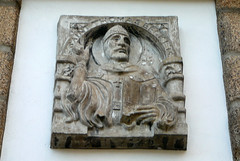
After the Restoration in 1660, several years were spent in repairing the building. The North West tower was found to be dangerous, it was demolished in the early 1830s and replaced by a copy of the South West tower, thus giving a symmetrical appearance to the west end of the Cathedral. During the Second World War, the Precincts were heavily damaged by enemy action and the Cathedral’s Library was destroyed. In 1954, the Library rebuilt and repairing War damage was completed.
A critical moment in the history of The Canterbury Cathedral was the murder of Thomas Becket in the north-west transept (also known as the Martyrdom) on Tuesday 29 December 1170 by knights of King Henry II. The king had frequent conflicts with the strong-willed Becket and is said to have exclaimed in frustration, "Who will rid me of this turbulent priest?" The knights took it literally and murdered Becket in his own cathedral. Becket was the second, out of the four Archbishops of Canterbury, who were murdered.
Related articles
- New Archbishop Of Canterbury 'Appointed' (news.sky.com)
Beautiful Churches - St. Basil's Cathedral, Red Square, Moscow, Russia
 |
| St. Basil's Cathedral, Red Square, Moscow, Russia |
 |
| Icon of St. Basil the Blessed |
According to the legend, missing ninth Church (precisely, sanctuary) was "miraculously found" during a ceremony attended by Tsar. Another popular legend is that Ivan the Terrible had the architect of St. Basil's eyes pulled out after the cathedral was completed so that the architect could not be able to build an equally beautiful structure anywhere else. Yet another legend tells that Napoleon after realizing that he could not count St. Basil's Cathedral among his war spoils, wanted it destroyed. The fuses lit by his men were supposedly snuffed by a sudden downpour.
Famous Churches - St. Peter's Basilica, Vatican City, Rome
 |
| St. Peters Basilica, Vatican City, Rome |
 |
| St. Peter’s Basilica, Vatican City, Rome |
 |
| St. Peter's Basilica (Photo credit: johnmaschak) |
 |
| St. Peter’s Basilica, Vatican City, Rome (Interior) |
Related articles
- Italian protester climbs down from St Peter's Basilica in Rome (news.yahoo.com)
- The Cathedral of the Good Shepherd
Famous Churches - St. Mark's Basilica (Basilica di San Marco),Venice, Italy
 |
| St. Mark's Basilica (Basilica di San Marco),Venice, Italy |
Sacred Destination -The Church of the Holy Sepulchre, Old City of Jerusalem
 |
| The Church of the Holy Sepulchre, Old City of Jerusalem |
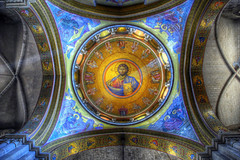 |
| Ceiling of the Church of the Holy Sepulchre (Photo credit: slack12) |
Related articles
- Unholy row erupts over Church of the Holy Sepulchre's water bill (independent.co.uk)
Famous Churches - Notre Dame Cathedral, Paris, France
 |
| Notre Dame Cathedral, Paris, France |
 |
| Notre Dame Cathedral, Paris, France (Window) |
 |
| Notre Dame Cathedral, Paris, France (Interior) |
Related articles
- Ding dang ... Notre Dame moves to scrap out-of-tune bells (guardian.co.uk)
Wednesday, 9 January 2013
Famous Churches - Chartres Cathedral,France
Chartres Cathedral (Cathédrale Notre-Dame de Chartres) is located in the medieval town of Chartres, about 50 miles from Paris. Chartres Cathedral is one of the greatest achievements in the history of architecture and it is almost perfectly preserved in its original design and details.
In addition to its architectural splendor, Chartres Cathedral has been a major pilgrimage destination since the early middle ages. According to popular belief, Chartres Cathedral has housed the tunic of the Blessed Virgin Mary, the Sancta Camisia, since 876. The relic was said to have been given to the cathedral by Charlemagne, who received it as a gift during a trip to Jerusalem. Chartres has been a very important Marian pilgrimage center and the faithful still come from the world over to honor the relic. In 1020, a glorious new Romanesque basilica with a massive crypt was built under the direction of Bishop Fulbert and later Geoffroy de Lèves. The cathedral
survived a fire in 1134 that destroyed much of the town. On the night
of June 10, 1194, lightning ignited a great fire that destroyed all but
the west towers, the façade and the crypt. Sancta Camisia was found unharmed in the treasury after three days, it was attributed as a miracle. After reconstruction, On October 24, 1260, Chartres Cathedral was finally dedicated in the presence of King Louis IX and his family. The cathedral was added to UNESCO's list of World Heritage Sites in 1979.
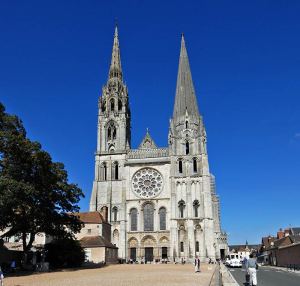 |
| Chartres Cathedral, Chartres, France |
Famous Churches - Basilica Sacré-Coeur (Basilica of the Sacred Heart), Paris, France
Montmartre, an area on a hill in the 18th arrondissement, north of downtown Paris, is known for its many artists who have been ubiquitous since 1880. The name Montmartre is said to be derived from either Mount of Martyrs or from Mount of Mars.
Sacré-Coeur Basilica (Basilica of the Sacred Heart) is positioned on a hilltop at the north end of the city; it can be seen from most places in Paris. The site of the 19th-century basilica is traditionally associated with the beheading of the city's patron, Saint Denis, in the 3rd century. According to legend, after he was martyred, Bishop Denis picked up his severed head and carried it several miles to the north, where the suburb of Saint-Denis stands today. Basilica Sacré-Coeur on Montmartre was begun in the troubled period of the 1870s to celebrate the triumph of "Christian Values" over the “Socialist Aspirations” of the Paris and Lyon communes. Entirely paid for by private donations, The Sacre Coeur was built between 1875 and 1919, amidst intense controversy with secularists and radicals. Architect Paul Abadie designed the Sacre Coeur .in a Romano Byzantine style, this architectural style stands in sharp contrast with other contemporary buildings in France, which were mostly built in a Romanesque style. Five architects continued the project after his death in 1885. Sacré-Coeur Basilica (Basilica of the Sacred Heart) waselevated to the status of a basilica in 1919, after the end of the First World War.
 |
| Sacré-Coeur Basilica (Basilica of the Sacred Heart), Paris, France |
Unique Churches - The Las Lajas Cathedral, Southern Colombia
 |
| Virgin of Rosary in las Lajas Cathedral (Photo credit: Wikipedia) |
The Las Lajas Cathedral is located in Southern Colombia and built in 1916 inside the canyon of the Guaitara River . According to the legend, this was the place where an Indian woman named Maria Mueses was carrying her deaf-mute daughter Rosa on her back near Las Lajas (”The Rocks”). Weary of the climb, the MarÃa sat down on a rock when Rosa spoke (for the first time) about an apparition in a cave. A few days later, the child Rosa disappeared from her home. After looking everywhere, the anguished Maria guessed that her daughter must have gone to the cave. The child had often said that the Lady was calling her. Maria ran to Las Lajas and found her daughter in front of a noble Lady and playing affectionately with a Child who had come down from His mother’s arms to let the girl enjoy His divine tenderness.Fearful of ridicule, Maria kept quiet about the episode. But she and Rosa frequently went to the cave to place wild flowers and candles in the cracks of the rocks.
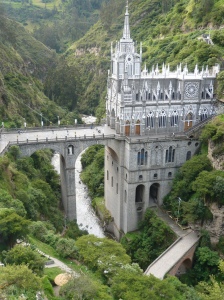 |
| The Las Lajas Cathedral, Southern Colombia |
The Cathedral
The Church is of Gothic Revival Architecture and was built from January 1, 1916 to August 20, 1949, with donations from local churchgoers, replacing an old nineteenth-century chapel. The name Laja comes from the name of a type of flat sedimentary rock similar to floor tiles found in the Andes Mountains. There was a claim that an apparition of the Virgin Mary was seen. The image on the stone is still visible today.
Famous Churches - The Sagrada Familia, Barcelona, Spain
The Sagrada Familia, Antoni Gaudí's unfinished masterpiece, is one of Barcelona's most popular tourist attractions. The architect Francisco de Paula del Villar designed a Neo Gothic Church and led the construction which started in 1882.
One year later, the modernist architect Antoni Gaudí took over as lead architect at the age of 31. From that moment on, Gaudí
devoted most of his life to the construction of the church. When he
died in 1926 only one facade (the nativity facade), one tower, the apse
and the crypt were finished. The artist was run over by a tram on the
Gran Via. He died in hospital two days later and was mourned by all of Catalonia. He is buried in the crypt of the Sagrada Familia. The work was interrupted by the outbreak of the Spanish Civil War in 1935. The building remained intact during the war, but in 1936 many of its models and plans were destroyed by Catalan anarchists. The last version of his design called for a church 95m/312ft long and 60m/197ft wide. The Sagrada Familia will have a total of 18 towers. Four Towers on each of the three facades represent the 12 apostles.
The towers reach a height of 90 to 120m (394ft). Another four towers
represent the 4 evangelists. They will surround the largest, 170m/558ft
tall tower, dedicated to Jesus Christ. The last tower, dedicated to Virgin Mary, will be built over the apse. Estimated completion dates of The Sagrada Familia range from 2017 to 2026, the 100th anniversary of Gaudi's death.
 |
| The Sagrada Familia, Barcelona, Spain |
Famous Churches - The Basilica of Our Lady of El Pilar in Zaragoza, Spain
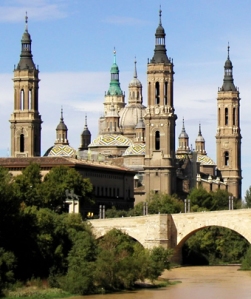 |
| The Basilica of Our Lady of El Pilar in Zaragoza, Spain |
 |
| The Basilica of Our Lady of El Pilar in Zaragoza, Spain |
The Legend
Basilica of Our Lady of El Pilar is one of the biggest and most important churches in Spain. St. James the Greater is born the son of Zebedee and Salome and brother of John the Evangelist. According to legend, in the early days of the Church, on January 2, 40 AD, the Apostle James the Greater was proclaiming the Gospel in Caesaraugusta (present day Zaragoza) by the River Ebro, when he saw Mary miraculously appearing in the flesh on a pillar calling him to return to Jerusalem. She gave him a small wooden statue of herself and a column of jasper and told him to build a church in her honor. The pillar is believed to be the same one venerated in Zaragoza, Spain today. Miraculous healings have been reported at the location. James then builds a chapel, the first built in honor of Mary. It was to become the first church in the world that was dedicated to the Blessed Virgin Mary. The jasper column and the wooden statue can still be seen on special occasions at the church. Before long, the chapel became a center for the conversion of pagans. Because of the apparition and the rapid rise of Christianity, Zaragozaquickly became a major political and commercial center. The simple chapel was often updated, growing in size into the existing Cathedral that was completed about the 17th century. Several chapels and churches were built at the site and destroyed with time.
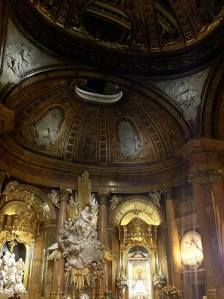 |
| The Basilica of Our Lady of El Pilar in Zaragoza, Spain (Interior) |
The current “The Basilica of Our Lady of El Pilar” was built between 1681 and 1686 by the King Carlos II. In 1725 the church commissioned the architect Ventura Rodriguez to transform the building to the Baroque style. The church now measures 130 by 67 meters. There are large corner towers and a central dome surrounded by ten brightly tiled cupolas. There are two domes that were painted with frescoes by Goya. One of them has the Queen of the Martyrs and the second one has the Adoration of the Name of God. The final reconstruction was finished in 1872.
Famous Churches - Milan's Cathedral Duomo in Italy
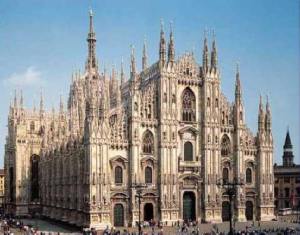 |
| Milan's Cathedral Duomo in Italy |
 |
| Interior - Milan's Cathedral Duomo, Italy |
Famous Churches - St. Mary Major (Santa Maria Maggiore), Esquiline Hill, Rome
The legend
Situated on the summit of the Esquiline Hill, St. Mary Major is the only one of the four patriarchal basilicas to have retained its paleo-Christian structures.
A wealthy but childless Roman couple, John and his wife decided to leave their fortune to the Church. They often prayed to the Virgin asking for guidance on how their wealth could be put to use. The Virgin appeared to them on the night of August 4th, 358 A.D. and told them that she wished a basilica to be constructed on the Esquiline Hill.
She would miraculously leave snow in the middle of the hot month of
August on the precise area in which she wanted the church. The next
morning John and his wife and Pope Liberius went to the top of the Equiline Hill which had been covered with snow. Pope Liberius immediately called for the construction of the Basilica. St. Mary Major (Santa Maria Maggiore) was completed in 360 A.D. Until 1969 the feast was known as Dedicatio Sanctæ Mariæ ad Nives (Dedication of the Church of Our Lady of the Snows), a name that had become popular for the Basilica in the fourteenth century in connection with a legend about its origin. Pope Sixtus III (432-40) decided to build a new and more magnificent structure near (if not on) the site of Liberius' former Marian Church. In 1741, a congregation set up by Pope Benedict XIV proposed that the reading of the legend be removed from the Roman Breviary and that the original name, "Dedicatio Sanctæ Mariæ", be restored. This recommendation was implemented only in 1969.
The Structure
The
monumental effect is due to the structure of the basilica and the
harmony that reigns among the principal architectural elements. The basilica is divided into a nave and two side aisles
by two rows of precious columns. Above these columns runs the
skillfully wrought entablature, interrupted at the transept by the grand
arches erected for the building of the Sistine and Pauline chapels. The area between the columns and the ceiling was once punctuated by large windows,
half of which still remain, while the other half have been covered over
by a wall. Over the walled windows, today one can admire frescos showing stories from the life of the Virgin. Above the window and frescos,
a wooden frieze adorned with an exquisite inlay of cupid-like figures
riding bulls unites the cornice with the ceiling. The bulls are the
symbol of the Borgia family; and the coat of arms of Callixtus III and Alexander VI, the Borgia popes, stand out at the center of the ceiling. The coffered ceiling was designed by Giuliano Sangallo and later completed by his brother Antonio.
In the crypt under the high altar lies the celebrated relic known as the Holy Crib. A statue of Pope Pius IX kneeling before the ancient wooden pieces of the manger serves as an example to the faithful who come to see the first humble crib of the Savior.
Situated on the summit of the Esquiline Hill, St. Mary Major is the only one of the four patriarchal basilicas to have retained its paleo-Christian structures.
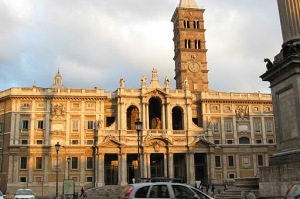 |
| St. Mary Major (Santa Maria Maggiore), Esquiline Hill, Rome |
The Structure
 |
| Interior - St. Mary Major |
In the crypt under the high altar lies the celebrated relic known as the Holy Crib. A statue of Pope Pius IX kneeling before the ancient wooden pieces of the manger serves as an example to the faithful who come to see the first humble crib of the Savior.
Famous Churches - The Churches of Peace at Jawor (Jauer) and Swidnica (Schweidnitz)
The Thirty Years' War in Europe ended with the Treaty of Westphalia (1648), which upheld the principle of cuius regio eius religio( the faith professed by the ruler was obligatory for his subjects). At that time Silesia was a part of the Catholic Habsburg monarchy.
In most of the province Protestants were persecuted and deprived of the right and possibility to practice their faith. Through the activity of the Lutheran king of Sweden, the Emperor finally allowed (1651-52) the erection of three churches, hereafter known as the Churches of Peace, in Silesian principalities under direct Habsburg rule in Glogow (Glogau), which ceased to exist in the 18th century, Jawor (Jauer), and Swidnica (Schweidnitz) in the south-west part of present-day Poland. The churches had to be built exclusively of perishable materials (wood and clay), located outside city walls,
and built in a limited period of time. These restrictions, together
with the need to provide adequate space for large crowds of worshippers,
forced the architect, Albrecht von Sabisch (1610-88), a prominent master-builder and fortification designer active in Wroclaw, to implement pioneering constructional and architectural solutions of a scale and complexity unknown ever before or since in wooden architecture. The timber-framed structures of enormous scale and complexity were assembled.
 |
| Wooden Church in Swidnica, Poland |
- The first permit was given to Glogow (1651) and the site was located 300m outside the city walls. Building started quickly and the first service was held in October 1652, but the church was destroyed by a violent storm in the summer of 1654. A new church was built the following year, but this burnt down in 1758 and was then replaced by a brick building.
- Church of Jawor. The permit for the other two churches was given in 1652; the Church of Jawor was built in 1654-55. The church itself is of a large size, he walls and ceiling are totally covered with white and blue ornaments. The floor of the church in Jawor is completely filled with rows and rows of wooden benches: it has room for 6000 people. There are no less than 143 biblical scenes painted on the walls, and an ornate high altar. A wonderfully preserved and original site, and still in use.
- Church of Swidnica.
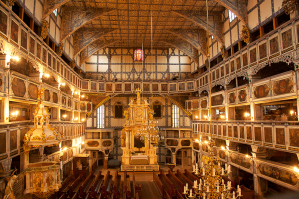
Church of Peace at Jawor, Poland In Swidnica a temporary structure (Gotteshüttlein, God's Hut) was built in 1652 and the actual construction was able to take place in 1656-57, thanks to the donation of Count Hans Heinrich von Hochberg and support from the Lutheran magistrate of Swidnica. A new sacristy was erected in 1695 and private pews were built by noble families in the early 18th century. Several auxiliary buildings were added to the ensemble, including the residences of the pastor and the vicars, a Latin school, and a German school. During the Silesian War, Swidnica was under siege on several occasions, and the hostilities resulted in the destruction of the sacristy and structural damage to the northern wall. All the damage was repaired by 1763.
Beautiful Churches - Rock Church (Temppeliaukio Kirkko), Helsinki
Rock Church (Temppeliaukio Kirkko) in Helsinkiis also known as "Church in the Rock," this modern church is carved from rock and has a stunning copper dome.
Looks
like a bomb shelter from the outside, but the interior is wonderful.
The Temppeliaukio/Tempelplatsen (Temple square) was selected as a
location for a church in the 1930s,butit was interrupted in its early
stages when the World War II began in 1939. Rock Church (Temppeliaukio Kirkko) was built in 1968-1969. If you thought you didn't like modern architecture for Churches; this will definitely change your mind. Rock Church (Temppeliaukio Kirkko) was designed by two architect brothers Timo and Tuomo Suomalainen, who chose a rocky outcrop as the site for their Church. Rock Church was built inside of a massive block of natural granite in the middle of Töölö, an ordinary residential square in Helsinki. The architects have built in a combination of natural and man-made features into the circular church and its features are quite striking. The walls are of bare rock, the ceiling is a giant disc made of entirely of copper wire and interior lighting is from natural light streaming through 180 vertical glass window panes that connect the dome and the wall. A solid copper-colored balcony provides a nice view of the church interior from above. The Lutheran Church is also frequently used to host classical concerts, with the raw rock walls, the acousticsare excellent.
There are no bells at the church, and a recording of bells composed by Taneli Kuusisto is played over the loudspeakers on the exterior wall. The dark and warm interior provides a beautiful place for worship. Rock Church (Temppeliaukio Kirkko Church) is one of the most famous tourist attractions in Helsinki.
Church Timings :
Monday to Tuesday - 10:00 AM to 08:00 PM,
Wednesday - 10:00 AM to 06:45 PM,
Thursday to Friday - 10:00 AM to 08:00 PM,
Saturday - 10:00 AM to 06:00 PM,
Sunday - 11:45 AM to 01:45 PM & 03:30 to 06:00 PM
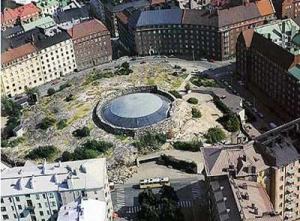 |
| Rock Church (Temppeliaukio Kirkko) in Helsinki |
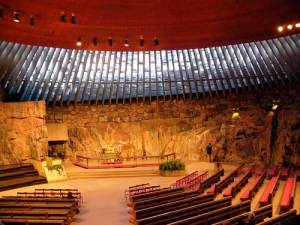 |
| Interior - Rock Church (Temppeliaukio Kirkko) |
Church Timings :
Monday to Tuesday - 10:00 AM to 08:00 PM,
Wednesday - 10:00 AM to 06:45 PM,
Thursday to Friday - 10:00 AM to 08:00 PM,
Saturday - 10:00 AM to 06:00 PM,
Sunday - 11:45 AM to 01:45 PM & 03:30 to 06:00 PM
Beautiful Churches - The Kyiv-Pechersk Lavra (Kiev Cave Monastery) in Ukraine
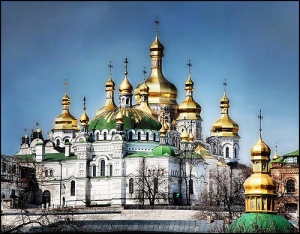 |
| The Kyiv-Pechersk Lavra (Kiev Cave Monastery) in Ukraine |
The Lavra (head monastery in Greek) is one of Byzantium's holiest sites, where Orthodox monks established their young religion until Batu Khan invaded and burned Kiev in 1274. Still magnificent with its onion-shaped spires and gold ornamentation, the Lavra is a visit to Ukraine's glorious past. It is still an active place of Orthodox worship. The caves on the property serve as burial grounds for monks. There are a complex system of underground tunnels 2 to 2.5 meters high and up to 1.5 meters wide. The tunnels accessible to visitors in the Short Caves are 228 m long, in the long Caves, 293 m long.
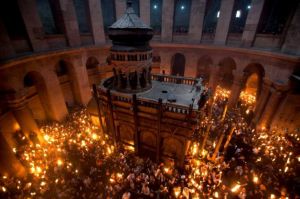 |
| The Kyiv-Pechersk Lavra (Interior) |
Beautiful Churches - Saint Vitus Cathedral at Prague, Czech Republic
The Cathedral, whose original name is St Vitus, St Wenceslas and St Adalbert Cathedral, is the biggest and the most important church in the Czech Republic. It’s the seat of the Archbishop of Prague and the place where saints, kings, princes and emperors of Bohemia are buried.
St. Vitus Cathedral is the spiritual symbol of the Czech State and a Gothic masterpiece. The original church, also named St. Vitus, was a Romanesque rotunda founded by Wenceslaus I, Duke of Bohemia in 925 and stood at the same location as the present day cathedral. The work on the St. Vitus Cathedral was started by Charles IV. It took nearly six centuries to complete. The original church, on a rotunda plan, was founded by "Good King" St. Wenceslas (Christmas carol fame) in 925. This was replaced with a Romanesque basilica in the late 11th century. Work on the present building began in 1344. Most of it was designed by the 22-year-old German architect Peter Parler, who also designed the Charles Bridge and other Prague landmarks. The Hussite Wars and the Thirty Years' War halted construction of the cathedral for several centuries. It was not until the 20th century that the western side of the cathedral and its two towers were completed. Although modern, they were constructed according to Parler's original plans. The interior of the cathedral is quite spacious and features a variety of intricately adorned chapels illuminated by the light going through amazingly designed stained glass windows depicting various sacred scenes.
The most important square Chapel of St. Wenceslas (Svatováclavská kaple) holds a 14th century tomb with the saint's holy relics. St. Wenceslas was prince of Bohemia and the "good king" of Christmas carols fame. St. Wenceslas Chapel is decorated with frescoes and semi-precious stones. A door in the south-western corner of the chapel leads to the Crown Chamber in which the Bohemian Coronation Jewels are stored. He founded the original church of St. Vitus on this site in 925 and was killed by his brother four years later. The chapel was built by Peter Parler between 1344 and 1364.
Church Timings
Monday to Saturday -9AM to 4PM
Sundays -12PM to 4PM
 |
| St. Vitus Cathedral, Prague, Czech Republic |
 |
| Interior - St. Vitus Cathedral, Prague |
Church Timings
Monday to Saturday -9AM to 4PM
Sundays -12PM to 4PM
Related articles
Subscribe to:
Posts (Atom)